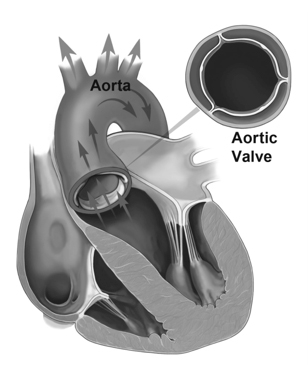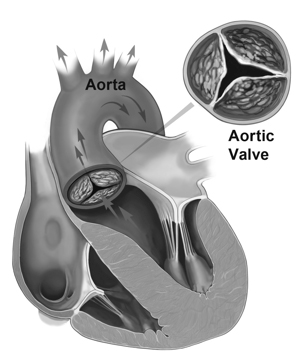About Transcatheter Aortic Valve Replacement (TAVR)
What is TAVR?
TAVR is a new way of replacing the aortic valve in your heart.
In the past, the only way to replace this valve was through open-heart surgery. Today, we can often use a long, thin tube (catheter) to replace the valve.
First, we make a small opening in a blood vessel in your leg. We then insert the catheter, threading it up through the blood vessel and into the heart. This catheter carries your new valve into the right position. The new valve is placed on top of your old valve.
You will be asleep for this surgery. The surgery can usually be done without a breathing tube. You will stay in the Heart & Vascular ICU (Intensive Care Unit) for a day or two. Most patients spend a total of two to three days in the hospital.
This drawing shows a healthy heart valve. The valve can open wide to let blood flow freely.

Why do I need my valve replaced?
You have a disease called aortic stenosis [ay-YOR-tik steh-NO-sis]. Aortic refers to one of four valves in your heart. This valve pumps blood from your heart through the rest of your body.
Stenosis means a narrowed heart valve. This mostly happens as people age. Over time, the valve stiffens and does not open or close properly. Less blood flows through the valve, and your heart has to work harder. This may make you feel short of breath, have chest pain, or feel faint or very tired.
This drawing shows a narrowed heart valve. The valve lets less blood through, which means less blood is pumped out to the body.

Is TAVR the best option for me?
To decide if this surgery is right for you, we need a lot of information about you, your heart and your general health.
Then, we will discuss with you all of your treatment options. The final choice will be yours. If you wish, you may continue with your current treatment.
To give us a complete picture of you and your health, you will need to complete the following tests:
Echocardiogram
This test uses sound waves to make an image of your heart. Your doctor uses this test to look at your heart valve.
CT Angiogram
You will lie on a table that moves into a scanner (a big machine with a hole in the middle). The scanner will take detailed pictures of your blood vessels. This will tell us if the blood vessels in your legs are big enough for the catheter that carries your new valve to your heart. This test often includes injecting contrast (X-ray) dye into a vein in your arm. We may change this test for you if your kidneys don’t work well.
Pulmonary (lung) Function Test
This is a breathing test to measure how well your lungs are working.
Coronary Angiogram (Heart Catheterization)
This test checks your heart and blood vessels. We insert a catheter into a blood vessel in your leg or arm, then we guide the catheter into your heart. Dye is injected through the catheter. The dye helps the heart and blood vessels be seen more clearly on the X-rays we take. During this test, your doctor may put catheters in your heart to measure the pressure in different areas of your heart. This is called right heart catheterization.
Dental X-Ray (Panorex)
A special X-ray that takes pictures of the teeth and jaw will be taken. This test is done to identify infection of the teeth.
We will do our best to set up all of your tests on the same one or two days.
Further workup may be required depending on the results of these tests. Your Heart Team will discuss this plan with you and your family.
What to bring to your visit:
- a list of medicines you take
- questions you have
- this handout
- a family member or friend
-
McLEOD REGIONAL MEDICAL CENTER FLORENCE
843-777-2000 -
McLEOD DARLINGTON
843-777-1100 -
McLEOD DILLON
843-774-4111 -
McLEOD LORIS
843-716-7000 -
McLEOD SEACOAST
843-390-8100 -
McLEOD CHERAW
843-537-7881 -
McLEOD CLARENDON
803-433-3000



-
McLEOD REGIONAL MEDICAL CENTER FLORENCE
843-777-2000 -
McLEOD DARLINGTON
843-777-1100 -
McLEOD DILLON
843-774-4111 -
McLEOD LORIS
843-716-7000 -
McLEOD SEACOAST
843-390-8100 -
McLEOD CHERAW
843-537-7881 -
McLEOD CLARENDON
803-433-3000
 Find a Doctor
Find a Doctor  Locations
Locations  Services
Services